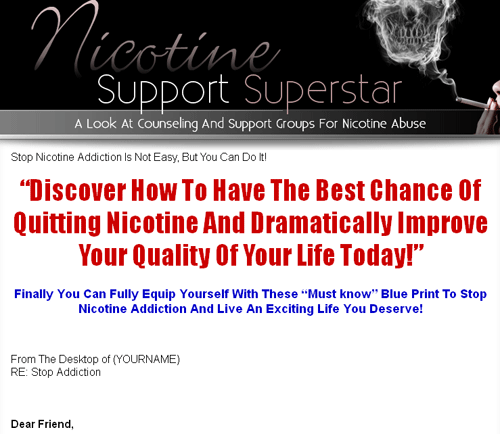Salespage Snapshot:

Table of Contents
Foreword
Chapter 1:
Nicotine Addiction Basics
Chapter 2:
Phone Support Lines
Chapter 3:
Quit Smoking Social Sites
Chapter 4:
Face To Face Support Groups
Chapter 5:
In Patient Treatment And Counseling
Chapter 6:
The Importance Of Nicotine Education And Prevention
Wrapping Up
Sample Content Preview
Chapter 5:
In Patient Treatment And Counseling
Synopsis
In patient treatment may be a big help for smokers who are attempting to quit. Simply fewer than 11% of smokers are able to stop without some type of therapy, according to the latest guideposts.
Treatment
However person-to-person treatment (which is found in inpatient care) increases the average success rate to about 17%.
Surely, medication is effective at checking withdrawal symptoms. However it still takes a good deal of effort and behavior therapy to stop smoking.
Though studies found that group psychotherapy and phone treatment step-up success rates, experts state that those methods can’t compare to a one-on-one session that’s tailored specifically to every patient.
In patient therapy is much more beneficial. Patients need a plan that’s customized simply for them. That’s something you can’t get on the Net or phone.
Person-to-person therapy is helpful for smokers who feel uncomfortable opening up in a group setting. It’s simply like a doctor’s visit. They don’t have to fret about their pride and they may openly vocalize their frustrations.
That was surely the case with one patient. Her in patient therapy session was instrumental in assisting her to quit. “I had too much pride to go to treatment when I had attempted to quit in the past—
I invited to do it on my own,” she says. “However treatment was truly what I needed. It helped me recognize what behaviors and patterns were causing me to need cigarettes.”
What occurs at an inpatient treatment session?
It’s hard to know precisely what to expect in a person-to-person session. There isn’t a one-size-fits-all plan.
As a whole, the first order of business is commonly to agree on a stop date and discuss how to brace oneself for it. We discuss how crucial it is to get rid of all cigarette stashes, ashtrays, and matches. A few counselors might also suggest informing your acquaintances and loved ones about your decision and enlisting their support.
When a stop date is set, counselors commonly ask smokers to center on the behaviors and stressors that put them at risk of lighting up. One way to accomplish this is to have smokers visually walk through their day and talk about when and where they acquire the urge to smoke. A few counselors might recommend keeping track of this in a diary.
Smoking is an implanted part of smoker’s lives. Treatment may help alter that by centering on the situations or emotions that influence individuals to smoke.
Visually going through their day made them realize what actions, like talking on the phone, triggered them to light up. It helps to open eyes.
Chapter 6:
The Importance Of Nicotine Education And Prevention
Synopsis
Smoking dependency, like alcohol addiction, is a true mental illness and disease.
What Is Crucial
While able to totally and comfortably arrest our chemical addiction, there’s no cure. It’s permanent. Like alcohol addiction there’s simply one rule.
Once we are free, just one, using only once and we have to go back. You see, it isn’t a matter of how much self-command we have, but how the brain’s priorities teacher teaches, how nerve and remembering cell highways that recorded years of smoking have left each of us wired for backsliding.
So why are a few individuals, social smokers, able to take it or leave it, while the rest of us became hooked? Called “chippers,” they plausibly account for less than ten percent of all smokers. Envious? If so and still using don’t fret, it’s normal. That’s what enslaved minds tend to dream about, to wish to become like them, to command what for us is unmanageable.
Being immune to addiction is believed to at least in part be related to genetic science. However with up to 90% of daily users hooked solid, spending 1000000s studying smoking dependency genetics is nearly laughable.
Before feeling too sorry for yourself, think what it’s like to be an alcohol-dependent and forced to watch roughly ninety percent of drinkers do something that you yourself can’t, to turn and walk away. We only have to watch the ten percent who are chippers.
Then again, we were each once chippers also, at least for our first couple of smokes or oral tobacco uses. There was no impulse, desire, crave, hunger or desiring for those first couple of cigarettes. Smoking stimulated our nervous system without our brain soliciting us to come back and do it once again.
There was no dopamine “aha” relief sensation, as nothing was missing and nothing in need of replenishment. However that was about to change.
Many of us became hooked while youngsters or teens. What none of us knew prior to that first hit of nicotine was how highly addictive smoking it was. Roughly twenty-six percent of us began losing control over continued smoking after just 3 to 4 smokes, rising to 44% after smoking 5 to 9.
What we didn’t then know was that inside 10 seconds of that very first puff, that up to fifty percent of our brain’s dopamine pathway acetylcholine receptors would get occupied by nicotine, or that before finishing that first butt that nicotine would saturate almost all of them.
Other Details- Ebook (PDF, DOC), 27 Pages
- Salespage (HTML, PSD)
- Squeeze Page (HTML)
- Ecover (PSD, JPG)
- Thank You, Earnings Disclaimer & Privacy Policy Page (HTML)
- File Size: 45,588 KB














